Religion In Indonesia
 From Nwe
From Nwe 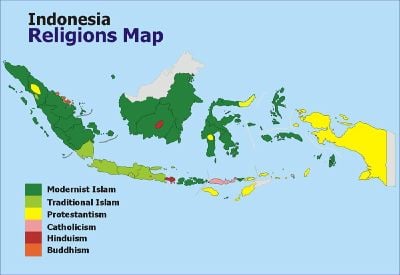
Religion plays a major role in life in Indonesia, which has the largest population of Muslims in the world. Many different religions are practiced in Indonesia and their collective influence on the country's political, economic, and cultural life is significant.
The Indonesian Constitution states "every person shall be free to choose and to practice the religion of his/her choice" and "guarantees all persons the freedom of worship, each according to his/her own religion or belief."[1] The government, however, officially only recognizes six religions, namely Islam, Protestantism, Catholicism, Hinduism, Buddhism and Confucianism.[2]
Indonesia has several flourishing religious communities that have lived in the area since ancient times. Indeed, Indonesia was once the heartland of successive Buddhist and Hindu kingdoms that used to rule the region prior to the advent of Islam. Even today, the island of Bali is still a flourishing center of Hinduism.
In order to preserve and to celebrate Indonesia's rich religious diversity, the Indonesian government has introduced the policy of Pancasila, which seeks to acknowledge and recognize its rich religious heritage. Indonesia provides its five major religions with constitutional protections and guarantees thereby offering a progressive model of religious harmony in the Muslim world.
History
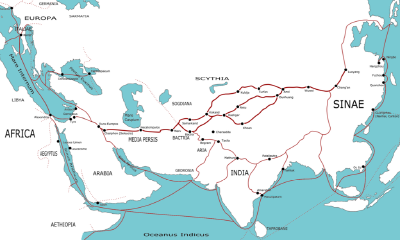
Historically, immigration has been a major contributor to the diversity of religion and culture within the country with immigration from India, China, Portugal, Arabian, and Netherlands.
Before the arrival of the Abrahamic religions of Christianity and Islam, the popular belief systems in the region were thoroughly influenced by dharmic traditions of Hinduism and Buddhism. These religions were brought to Indonesia around the second and fourth centuries, respectively, when Indian traders arrived on the islands of Sumatra, Java and Sulawesi. Hinduism started to develop in Java in the fifth century C.E. with the Brahmin worship of Shiva. The traders also established Buddhism in Indonesia, which developed further in the following century and a number of Hindu and Buddhist influenced kingdoms were established, such as Kutai, Srivijaya, Majapahit, and Sailendra. The world's largest Buddhist monument, Borobudur, was built by the Kingdom of Sailendra and around the same time, the Hindu monument Prambanan was also built. The peak of Hindu-Javanese civilization was the Majapahit Empire in the fourteenth century, described as a golden age in Indonesian history.[3]
Islam was introduced to Indonesia in the fourteenth century. Coming from Gujarat, India, Islam spread through the west coast of Sumatra and then developed to the east in Java. This period also saw kingdoms established but this time with Muslim influence, namely Demak, Pajang, Mataram and Banten. By the end of the fifteenth century, 20 Islamic-based kingdoms had been established, reflecting the domination of Islam in Indonesia.
The Portuguese introduced Roman Catholicism into Indonesia, notably to the island of Flores and to what was to become East Timor. Protestantism was first introduced by the Dutch in the sixteenth century with Calvinist and Lutheran influences. Animist areas in eastern Indonesia, on the other hand, were the main focus Dutch conversion efforts, including Maluku, Nusa Tenggara, Papua and Kalimantan. Later, Christianity spread from the coastal ports of Borneo and missionaries arrived among the Torajans on Sulawesi. Parts of Sumatra were also missionized, most notably the Batak people, who are predominantly Protestant today.
Significant changes in Indonesia's religious landscape occurred during the modern period called the New Order era.[4] Between 1964 and 1965, the tension between the Communist Party of Indonesia (Partai Komunis Indonesia or PKI) and the Indonesian government, along with some organizations, resulted in mass murders.[5] Following the incident, the New Order government had tried to suppress the supporters of PKI, by applying a policy that everyone must choose a religion, since PKI supporters were mostly atheists.[4] As a result, every Indonesian citizen was required to carry personal identification cards indicating their religion. The policy resulted in a mass religion conversions, topped by conversions to Protestantism and Catholicism (Christianity).[4] The same situation happened with Indonesians with Chinese ethnicity, who mostly were Confucianists. Because Confucianism was not one of the state recognized religions at the time, many Chinese Indonesians were also converted to Christianity.[4]
State Recognized Religions
Islam
Indonesia is the world's most populous Muslim-majority country, with 88 percent of its citizens identifying themselves as Muslim. Traditionally, Muslims have been concentrated in the more populous western islands of Indonesia such as Java and Sumatra. In less populous eastern islands, the Muslim population is proportionally lower. Around 99 percent of Indonesian Muslims are Sunnis. The remaining Muslims are Shia and are concentrated in Aceh province.
The history of Islam in Indonesia is complex and reflects the richness and diversity of Indonesian cultures.[6] In the twelfth century, many predominantly Muslim traders from India arrived on the island of Sumatra, Java and Kalimantan where the religion flourished between the twelfth and fifteenth centuries. The dominant Hindu and Buddhist kingdoms of the time, such as Majapahit and Sriwijaya, were in decline and the numerous Hindus and Buddhists mostly converted to Islam, although a smaller number, as in the notable case of Hindus emigrating to Bali, moved off Java and Sumatra.[6]
Political parties based on moderate and tolerant Islamic interpretations have had significant, but not dominant success in the national parliamentary elections in 1999 and 2004. Hardline Islamist parties, however, have had little electoral success. Nonetheless, a number of fundamentalist groups have been established, including the Majelis Mujahiden (MMI) and their alleged associates Jamaah Islamiyah (JI).
Christianity
The Government of Indonesia officially recognizes the two main Christian divisions in Indonesia, Protestantism and Roman Catholicism, as two separate religions.
Protestantism
Protestantism arrived in Indonesia during the Dutch East Indies colonization, around the sixteenth century. The Dutch policy to ban Catholicism significantly increased the percentage of Protestant believers in Indonesia. Protestantism has expanded considerably in the twentieth century, marked by the arrival of European missionaries in some parts of the country, such as Western New Guinea and Lesser Sunda Islands.[7] Following the 1965 coup, all non-religious people were recognized as Atheist, and hence did not receive a balanced treatment compared to the rest of the citizens.[7] As a result, Protestant churches experienced a significant growth of members, partly due to the uncomfortable feeling towards the political aspirations of Islamic parties.
Protestants form a significant minority in some parts of the country. For example, on the island of Sulawesi, 17 percent of the citizens are Protestants, particularly in Tana Toraja and Central Sulawesi. Furthermore, up to 65 percent of the Torajan population is Protestant. In some parts of the country, entire villages belong to a distinct denomination, such as Seventh Day Adventist, International Church of the Foursquare Gospel, Lutheran, Presbyterian, or Salvation Army (Bala Keselamatan) depending on the success of missionary activity.[8] Indonesia has two Protestant-majority provinces, which are Papua and North Sulawesi. In Papua, the faith is most widely practiced among the native Papuan population. Today most of the population native to North Sulawesi practice some form of Protestantism, while transmigrants from Java and Madura practice Islam.
Roman Catholicism
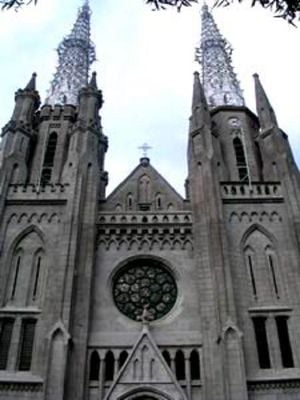
Roman Catholicism arrived in Indonesia during the Portuguese arrival with spice trading.[7] Many Portuguese had the goal of spreading Roman Catholicism in Indonesia, starting with Maluku islands in 1534. Between 1546 and 1547, the pioneer Christian missionary, Francis Xavier, visited the islands and baptized several thousand locals.
During the Dutch East Indies era, the number of Roman Catholicism practitioners fell significantly, due to the Dutch policy to ban the religion. The most significant result was on the island of Flores and East Timor, where the Dutch concentrated. Roman Catholic priests were sent to prisons and replaced by Protestant priests from the Netherlands.[7] One Roman Catholic priest was executed for celebrating Mass in a prison during Jan Pieterszoon Coen's tenure as Governor-General of the Dutch East Indies.
As of 2006, 3 percent of all Indonesians were Catholics, slightly lower than the total number of Protestants. The practitioners mostly live in Papua and Flores.
On September 22, 2006, there was a massive strike by the Catholics, concentrated mainly on Flores Island following the execution of three Roman Catholic men.[9] Fabianus Tibo, Marinus Riwu, and Dominggus da Silva were convicted in 2001 of leading a Christian militia that killed at least 70 Muslims in 2000. However, human rights groups had questioned the fairness of the trial: claiming that although the three participated in the militia, they were not the leaders.[9]
Hinduism
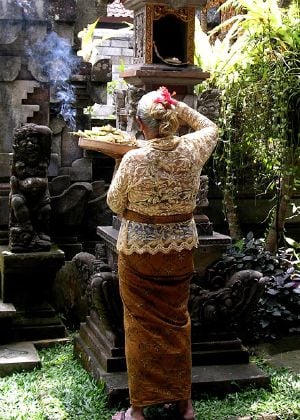
Hindu culture and religion arrived in the Indonesian archipelago in the first century, later coinciding with the arrival of Buddhism, resulting in a number of Hindu-Buddhist empires such as Kutai, Mataram, and Majapahit. The Prambanan Temple complex was built during the era of Hindu Mataram, during the Sanjaya dynasty. The greatest Hindu empire that ever flourished in Indonesian archipelago was the Majapahit empire. This age of Hindu-Buddhist empires lasted until the sixteenth century, when the archipelago's Islamic empires began to expand. This period, known as the Hindu-Indonesia period, lasted for sixteen full centuries. The influence of Hinduism and classical India remain defining traits of Indonesian culture; the Indian concept of the god-king still shapes Indonesian concepts of leadership and the use of Sanskrit in courtly literature and adaptations of Indian mythology such as the Ramayana and Mahabharata.
Hinduism in Indonesia, formally referred as Agama Hindu Dharma, takes on a tone distinct from other parts of the world. For instance, it never applied the caste system. Additionally, rather than focusing on cycles of rebirth and reincarnation, Hinduism in Indonesia is concerned more with a myriad of local and ancestral spirits. In addition, the religion focuses more on art and ritual rather than scriptures, laws and beliefs. All practitioners of Agama Hindu Dharma share many common beliefs, mostly the Five Points of Philosophy: the Panca Srada.[10] These include the belief in one Almighty God, belief in the souls and spirits and karma or the belief in the law of reciprocal actions.
Buddhism
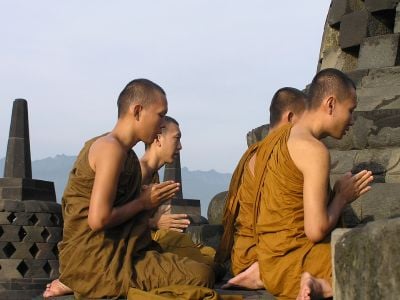
Buddhism is the second oldest religion in Indonesia, arriving around the sixth century.[11] The history of Buddhism in Indonesia is closely related to the history of Hinduism, as a number of empires based on Buddhist culture were established around the same period. The Indonesian archipelago has witnessed the rise and fall of powerful Buddhist empires such as Sailendra dynasty, Srivijaya and Mataram Empires. The arrival of Buddhism began with the trading activity that began in the early of first century on the Silk Road between Indonesia and India.[12] The Chinese traveler monk, Xuanzang, on his journey to India, has witnessed the powerful maritime empire of Srivijaya based on Sumatra. The empire also served as a Buddhist learning center in the region. A number of historical heritages can be found in Indonesia, including the Borobudur Temple in Yogyakarta and statues or prasasti (inscriptions) from the earlier history of Buddhist empires.
Following the downfall of President Sukarno in the mid-1960s, Pancasila was reasserted as the official Indonesian policy on religion to only recognize monotheism.[13] As a result, founder of Perbuddhi (Indonesian Buddhists Organisation), Bhikku Ashin Jinarakkhita, proposed that there was a single supreme deity, Sang Hyang Adi Buddha. He was also backed up with the history behind the Indonesian version of Buddhism in ancient Javanese texts, and the shape of the Borobudur Temple.
According to the 1990 national census, slightly more than one percent of the total citizens of Indonesia are Buddhists, which takes up about 1.8 million people. Most Buddhists are concentrated in Jakarta, although other provinces such as Riau, North Sumatra and West Kalimantan also have a significant number of practitioners. However, these totals are likely high, due to the fact that practitioners of Confucianism and Daoism, which are not considered official religions of Indonesia, referred to themselves as Buddhists on the census.
Confucianism
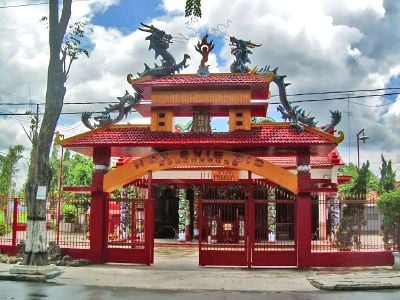
Confucianism originated from the Chinese mainland and was brought by Chinese merchants and immigrants. It is estimated as late as the third century C.E. that the Chinese arrived in Nusantara archipelago.[2] Unlike other religions, Confucianism evolved more into loose individual practices and belief as a code of conduct, rather than a well-organized community religion, or way of life or social movement. It was not until the early of 1900s that Confucianists formed an organization, called Tiong Hoa Hwee Koan (THHK) in Batavia (now Jakarta).[2]
After the independence of Indonesia in 1945, Confucianism in Indonesia was affected by several political turmoils and has been used for some political interests. In 1965, Sukarno issued Presidential Decree No. 1/Pn.Ps/1965, in which six religions were officially recognized and embraced by the Indonesian people, including Confucianism.[2] Earlier in 1961, the Association of Khung Chiao Hui Indonesia (PKCHI), a Confucianist organization, declared that Confucianism is a religion and Confucius is their prophet.
In 1967, Sukarno was replaced by Suharto, marking the New Order era. Under Suharto rule, the anti-China policy was applied to gain political support from the people, especially after the fall of Indonesian Communist Party, which is claimed to have been backed by China.[2] Suharto issued the controversial Presidential Instruction No. 14/1967, which practically banned Chinese culture, expression of Chinese belief, Chinese celebrations and festivities, as well as forcing many Chinese to change their name. Yet, in the same year, Suharto addressed "The Confucian religion deserves a decent place in this country," in front of the PKCHI national convention.[2]
In 1969, Statute No. 5/1969 was passed and it re-iterated the official six religions from the 1967 presidential decree. However, it was different in practice. In 1978, the Minister of Home Affairs issued its directive that there are only five religions, excluding Confucianism.[2] On January 27, 1979, a presidential cabinet meeting took place and it firmly decided that Confucianism is not a religion. Another Minister of Home Affairs was issued in 1990 re-iterating about five official religions in Indonesia.
Hence the status of Confucianism in Indonesia in the New Order era was never clear. De jure, there were conflicting laws, as the higher law permitted Confucianism, but the lower law did not recognize it. De facto, Confucianists were not recognized by the government and they were forced to become Christians or Buddhists to maintain their citizenship. This practice was applied in many places, including in the national registration card, marriage registration, and even civic education in Indonesia taught school children that there are only Five official religions.[2]
With the fall of Suharto in 1998, Abdurrahman Wahid was elected as the fourth president. Wahid lifted the Presidential Instruction No. 14/1967 and the 1978 Minister of Home Affairs directive. Confucianism is now officially recognized as a religion in Indonesia. Chinese culture and all related Chinese-affiliated activities are now allowed to be practiced. Chinese and non-Chinese Confucianists have since then expressed their beliefs in freedom.
Other religions and beliefs
Animism
Animism (the belief in, and worship of, spirits found in nature or people) has existed since Indonesia's earliest history. Furthermore, two thousand years later, with the existence of Islam, Christianity, Hinduism, Buddhism, Confucianism and other religion, Animism still exists in some parts of Indonesia. However, this belief is not accepted as Indonesia's official religion as the Pancasila states the belief in the supreme deity, or monotheism.
Judaism
There are small unrecognized Jewish communities in Jakarta and Surabaya. An early Jewish settlement in the archipelago was through the Dutch Jews who came for the spice trade. In the 1850s, about 20 Jewish families of Dutch and German origins lived in Jakarta (then Batavia). Some lived in Semarang and Surabaya. Several Baghdadi Jews also settled in the island. Prior to 1945, there were about 2000 Dutch Jews in Indonesia. In 1957, it was reported around 450 Jews remained, mainly Ashkenazim in Jakarta and Sephardim in Surabaya. The community has decreased to 50 in 1963. In 1997, there were only 20 Jews, some of them in Jakarta and a few Baghdadi families in Surabaya.[14]
Jews in Surabaya maintain a synagogue, the only synagogue in Indonesia. They have little contact with Jews outside the country. There is no service given in the synagogue.[15]
Inter-religious relations
Although the Indonesian government recognizes a number of different religions, inter-religious conflict sometimes is unavoidable. In the New Order era, former president Suharto proposed the Anti-Chinese law that prohibited anything related to Chinese culture, including names and religions. Nevertheless, positive form of relations have also appeared in the society, such as the joint effort among six different religious organizations to help the 2004 Tsunami victims.
Between 1966 and 1998, Suharto made an effort to "de-Islamicize" the government, by maintaining a large proportion of Christians in his cabinet. However, in the early 1990s, the issue of Islamization appeared, and the military split into two groups, the Nationalist and Islamic camps. The Islamic camp, led by General Prabowo, was in favor of Islamization, while General Wiranto was in the Nationalist group, in favor of a secular state.
During the Suharto era, the Indonesian transmigration program continued, after it was initiated by the Dutch East Indies government in the early nineteenth century. The intention of the program was to move millions of Indonesians from over-crowded populated Java, Bali and Madura to other less populated regions, such as Ambon, Lesser Sunda Islands and Papua. It has received much criticism, being described as a type of colonization by the Javanese and Madurese, who also brought Islam to non-Muslim areas. Citizens in western Indonesia are mostly Muslims with Christians a small minority, while in eastern regions the Christian populations are similar in size or larger than Muslim populations. This more even population distribution has led to more religious conflicts in the eastern regions, including Poso and Maluku, since the resignation of President Suharto.
The government has made an effort to reduce the tension by proposing the inter-religion co-operation plan.[16] The Foreign Ministry, along with the biggest Islamic organization in Indonesia, Nahdatul Ulama, held the International Conference of Islamic Scholars, to promote Islamic moderation, which is believed to reduce the tension in the country.[16] On December 6, 2004, the "Dialogue On Interfaith Cooperation: Community Building and Harmony" conference was opened. The conference, which was attended by ASEAN countries, Australia, Timor Leste, New Zealand and Papua New Guinea, was intended to discuss possible co-operation between different religious groups to minimize inter-religious conflict in Indonesia.[16] The Australian government, represented by the Foreign Minister Alexander Downer, supported the dialogue initiative by co-hosting it.
Notes
- ↑ Indonesia's Constitution of 1945, Reinstated in 1959, with Amendments through 2002. Retrieved July 26, 2021.
- ↑ 2.0 2.1 2.2 2.3 2.4 2.5 2.6 2.7 Heriyanto Yang, The History and Legal Position of Confucianism in Post Independence Indonesia Marburg Journal of Religion 10(1) (2005). Retrieved July 26, 2021.
- ↑ John I. Pariwono, Abdul Gani Ilahude, and Malikusworo Hutomo, Progress in Oceanography of the Indonesian Seas: A Historical Perspective Oceanography 18(4) (December 2005). Retrieved July 26, 2021.
- ↑ 4.0 4.1 4.2 4.3 Jaques Bertrand, Nationalism and Ethnic Conflict in Indonesia (Cambridge University Press, 2004, ISBN 0521524415).
- ↑ George McTurnan Kahin and Audrey R. Kahin, Subversion as Foreign Policy: The Secret Eisenhower and Dulles Debacle in Indonesia (New York: The New Press, 1995, ISBN 1565842448).
- ↑ 6.0 6.1 William H. Frederick and Robert L. Worden (eds), Islam Indonesia: A Country Study (Washington, DC: GPO for the Library of Congress, 1993). Retrieved July 26, 2021.
- ↑ 7.0 7.1 7.2 7.3 William H. Frederick and Robert L. Worden (eds), Christianity Indonesia: A Country Study (Washington, DC: GPO for the Library of Congress, 1993). Retrieved July 26, 2021.
- ↑ Indonesia - (Asia) Reformed Online. Retrieved July 26, 2021.
- ↑ 9.0 9.1 Kate Heneroty, Indonesia execution of Catholic militants incites rioting Jurist, September 22, 2006. Retrieved July 26, 2021.
- ↑ Luh Ketut Suryani, Balinese Women in a Changing Society Journal of the American Academy of Psychoanalysis and Dynamic Psychiatry 32 (1)(2004). Retrieved July 26, 2021.
- ↑ Buddhism in Indonesia BDEA Inc. & BuddhaNet. Retrieved July 26, 2021.
- ↑ Buddhist arts in Indonesia Asian Art. Retrieved July 26, 2021.
- ↑ William H. Frederick and Robert L. Worden (eds), Buddhism Indonesia: A Country Study (Washington, DC: GPO for the Library of Congress, 1993). Retrieved July 26, 2021.
- ↑ The Jewish Community of Indonesia Museum of the Jewish People. Retrieved July 26, 2021.
- ↑ Larry Polansky, The Surabaya, Indonesia Jewish Community. Retrieved July 26, 2021.
- ↑ 16.0 16.1 16.2 Transcript of Joint Australia Indonesia press conference: 18 March 2005 Parliament of Australia. Retrieved July 26, 2021.
References
ISBN links support NWE through referral fees
- Bertrand, J. Nationalism and Ethnic Conflict in Indonesia. Cambridge: Cambridge University Press, 2004. ISBN 0521818893.
- Cheu, Hock Tong. Chinese Beliefs and Practices in Southeast Asia: Studies on the Chinese Religion in Malaysia, Singapore and Indonesia. Pelanduk Publications, 1999. ISBN 978-9679784527.
- Frederick, William H., and Robert L. Worden (eds). Indonesia: A Country Study. Washington, DC: GPO for the Library of Congress, 1993. Retrieved July 26, 2021.
- Kahin, George McTurnan, and Audrey R. Kahin. Subversion as Foreign Policy: The Secret Eisenhower and Dulles Debacle in Indonesia. New York, NY: The New Press, 1995. ISBN 1565842448.
- Lloyd, G. and S. Smith. Indonesia Today. Lanham, MD: Rowman & Littlefield Publishers, 2001. ISBN 0742517616.
Credits
New World Encyclopedia writers and editors rewrote and completed the Wikipedia article in accordance with New World Encyclopedia standards. This article abides by terms of the Creative Commons CC-by-sa 3.0 License (CC-by-sa), which may be used and disseminated with proper attribution. Credit is due under the terms of this license that can reference both the New World Encyclopedia contributors and the selfless volunteer contributors of the Wikimedia Foundation. To cite this article click here for a list of acceptable citing formats.The history of earlier contributions by wikipedians is accessible to researchers here:
- Religion in Indonesia history
The history of this article since it was imported to New World Encyclopedia:
- History of "Religion in Indonesia"
Note: Some restrictions may apply to use of individual images which are separately licensed.
↧ Download as ZWI file | Last modified: 02/03/2023 23:43:31 | 34 views
☰ Source: https://www.newworldencyclopedia.org/entry/Religion_in_Indonesia | License: CC BY-SA 3.0
 ZWI signed:
ZWI signed: KSF
KSF